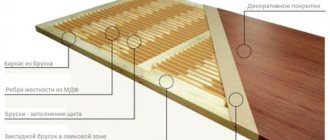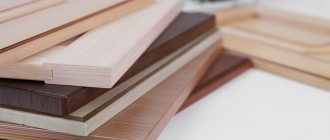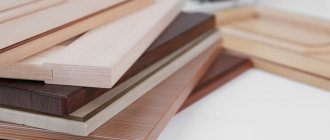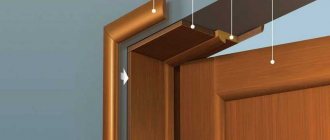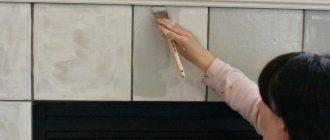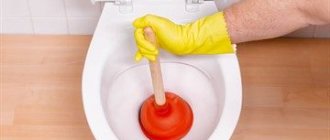Miscellaneous
The decorative covering of a door deteriorates over time and loses its attractiveness. If the old paint is cracked and peeling in places, it is recommended to remove the old coating before applying a new coat. But it also happens that the surface has only lost its shine, has become dull, or spots have appeared on it, but the layer itself lies smoothly and has retained its integrity. In such cases, there is no point in carrying out work to remove the old coating. It will not be possible to qualitatively remove the old layer of paint that has retained its strength. It is difficult to remove. As a result, you can only damage the doors or get a surface whose quality is much lower than the original version.
Rules for choosing paint
Acrylic paint is odorless and dries quickly.
The choice depends on the desired result and painting conditions. Interior doors are treated within the living space, so an odorless finishing product is used so as not to cause allergies or health problems.
There are several types of paints on the construction market:
- oil;
- water-dispersed;
- latex;
- acrylic;
- alkyd.
Oily ones contain oils that do not give off a strong odor. Paints are pigments based on drying oil, which acts as a solvent. Oil paint compositions can be colored or colorless. For new wooden doors, the second type is used, and previously finished ones are repainted with tinted compounds.
Water-dispersed products use water as a solvent, so they have almost no odor. Harmless products are used in children's rooms and bedrooms; during the application process they do not harm human skin upon contact.
Latex enamels are not toxic products; they do not have an unpleasant odor. The paint dries quickly, a film appears after 20 minutes, and full hardening occurs after 1 hour of waiting. The binder is styrene butadiene (synthetic resin).
Acrylic products do not smell because there are no toxins in the mixture. Acrylic-based paints are safe for people during the painting process and after drying during use. Alkyd compounds are not all odorless, but there are appropriate options. There are glossy, matte, semi-matte enamels, the use of which is recommended in rooms where people with allergies live.
How to carry out the procedure professionally?
The attractiveness of the new finish depends on the accurate execution of all stages of work , which include preparing the canvas (removing the old coating, eliminating defects), sanding and careful painting. How to repaint an interior door made of laminated wood or another material into a different or the same color with your own hands is discussed in detail below.
Surface preparation
Procedure:
- remove the sash from its hinges, remove all fittings (locking mechanism, handle), glass inserts, or insulate these elements with masking tape or foil;
- lay the canvas in a horizontal position, cover the floor and adjacent surfaces with newspapers or plastic film - this will help you avoid the additional work of wiping off paint that accidentally gets past the “target”;
- close the hole for the lock with tape or plug it with cotton wool;
- remove the old finish in any way;
- carefully inspect the cleaned product, assess the condition of the canvas.
Elimination of defects
Any cracks, scratches, gaps or chips on the door will appear under the paint and will be noticeable. Therefore, smooth the canvas that has defects with wood putty :
- take a small amount of the mixture onto a rubber spatula and apply to the damaged area;
- spread the mixture in an even layer and let the putty dry.
Advice
After the composition has hardened, clean the area with the mixture with sandpaper so that no roughness or unevenness remains on the canvas.
Grinding
- Regardless of the method of sanding the door (manually or with a grinder with an emery disc), the procedure begins with processing the surface with coarse sandpaper and ends with fine abrasive material - this step-by-step implementation will ensure the creation of a perfectly smooth surface.
- After processing with a grinder, small circular scratches remain on the product, so the mandatory finishing stage of mechanized grinding is sanding the sash manually with fine sandpaper. When sanding, move your hands in the direction of the grain.
- At the end of the work, remove dust and construction debris with a vacuum cleaner, and clean the canvas with a sponge.
When processing a wooden figured part of a door, use fine sandpaper, which you first crumple several times with your hands: thanks to this trick, the paper will become softer and fit more tightly to the relief pattern.
Required tools and materials
Container and roller for painting doors
To clean the surface of the door frame and leaf, use a hair dryer, a grinding machine, or manually remove the layer of old paint using emery cloths. The surface is painted using a roller, brush or spray. For primer and paint you need separate brushes or roller handle attachments. You can wash used ones with solvent, but it is better to take new ones.
The roller is used on flat surfaces of the door and on long surfaces of the door opening. Hard-to-reach places are painted with brushes. The sprayer can be used if you have experience working with it. To use it, the surrounding area is covered with old newspapers or polyethylene.
To lay the canvas in working position, use an old table or special trestles - two stands made of wood or reinforcement.
Other tools:
- hammer, screwdriver, pliers;
- pallets for diluting paint, varnish, primer;
- masking tape;
- spatula, sanding machine, rags.
You will need wood putty; it is usually ready for use and packaged in small containers of 200–250 grams. Take concentrated soil and dilute it according to the instructions on the package. Paint is purchased in accordance with its intended purpose.
Sandpaper is taken No. 60 for large irregularities and No. 120 - 240 for cleaning the putty surface.
Can the door surface be repainted?
Tip
Renewing the finishing coating returns the door's attractiveness. This is a worthy alternative to completely replacing the canvas.
But sometimes restoration of the external part may be impractical due to significant damage:
- The presence of rot or mold on the material. If destructive processes have affected only the front covering, the sash is repainted, having previously cleaned the problem areas. If rotting is observed throughout the entire thickness of the material, updating the outer layer does not make sense.
- The presence of significant damage: deep chips, unevenness, violation of the geometry of the sash, severe delamination of the canvas, dilapidation of the material. To restore the door, ordinary painting will not be enough: defects are eliminated by deep sanding followed by the use of leveling mixtures or the product is replaced with a new one.
Features of painting interior doors with your own hands
Old varnish can be removed with a sander.
When using a brush, paint in one direction to hide lint marks as much as possible. This method is almost never used due to the sloppy final result. A roller is used more often because it rolls out the paint evenly and leaves no marks. For paints based on acetone, white spirit and solvent, you cannot use a foam nozzle, as the surface will become unusable after several rollings.
There is an option to use a spray gun if the house has several doors to be painted. It is not profitable to rent expensive equipment for one unit.
If the canvas is covered with veneer, it is better not to destroy its integrity during preparation. For cleaning, use a soft rag or brush, and hard-to-reach areas are treated with fine sandpaper. Dust is removed with a brush.
Before painting, clean the floor in the room with a vacuum cleaner or carefully sweep it with a broom, then wipe it with a wet cloth so that dust particles do not settle on the painted surface.
Imitation of natural wood
To repaint interior doors in an apartment, it is not always enough to simply apply several layers of paint. Sometimes you want to see the natural pattern of wood on the surface of the canvas. If your doors are made of MDF or lined with regular plywood, they can be painted to imitate natural wood. There are two methods on how to do this.
Option one
The door leaf is coated with light-colored paint. It is recommended to choose gray, beige or yellowish undertones. When the layer is completely dry, apply liquid soap with a wide brush. A layer of darker paint is applied on top (you can choose dark brown or a “wenge” color). Excess liquid soap will begin to appear through this layer - it should be washed off. The result is a coating with a wood fiber pattern.
Option two
First, the door is covered with paint of one color (also light), after drying, a second layer of darker paint. Take a special brush with a textured surface (it can be purchased at any hardware store) and run it over the still damp surface. This is how lines and curls spontaneously appear, which together give an imitation of a wood pattern. After drying, the decorative layer is sanded to give it a natural look and varnished.
As you can see, there are different ways to paint doors at home. Correctly selected coloring composition and adherence to technology will allow you to obtain a high-quality, durable and aesthetically attractive coating. The choice of color and decor of interior doors is a matter of taste.
A simple technology for painting a door for three pennies (1 video)
Coloring options (50 photos)
Preparatory work
In order for the door to dry faster, before painting it must be removed from its hinges and taken outside.
A new wooden door is treated with antiseptic compounds and primed. On a previously painted sash, remove the paint if it has peeled off and does not adhere well. The smooth and solid coating is not touched, only sanded with sandpaper and painted in another chosen color. Natural wood is sanded to an ideal surface.
To make it convenient to work, perform the following steps:
- the canvas is removed from the hinges, sometimes you just need to lift the sash and remove it from the hinge pin, in other cases the screws on the hinge are unscrewed;
- remove the lock, handle, decorative lining on the key cavity.
It is best to remove the old layer with a hair dryer. You need help with a spatula and sandpaper. After heating, use a spatula to pry off the paint film and remove it. The remaining particles are sanded off. You need to work carefully so as not to damage the door area.
You can use paint remover. The solution penetrates deep into the film and makes it soft, after which it can be easily removed with a spatula. The chemical method works faster, but the product is toxic; you need to use a respirator. With the use of the product, the risk of damaging the area is reduced; the solution is inexpensive.
Putty completes the preparatory stage. The canvas is leveled over the entire area or only cracks are sealed. After the putty has dried, the layer is sanded to a perfect surface.
